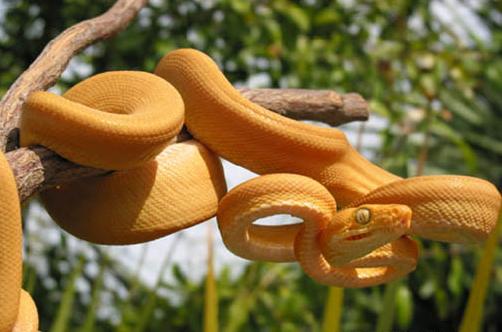Boa - Cook's Tree
Cooks Tree Boa Scientific Name: Corallus enydris cooki
Mon, 28th April, 2025 - 8:42 am GMT
Sponsor Ads:

Alternative Name
Cooks Tree Boa Scientific Name: Corallus enydris cookiBasic Info
Cook's Tree Boas average between five and six feet in length. They are very slender, enabling distribution of their weight throughout the body. This makes residing in and traveling through trees much easier. They are usually yellowish in color.
Health
Cook's Tree Boas should be kept in a tall enclosure. When feeding, Cook's Tree Boas should be separated. They can be fed mice, although they often prefer birds. The temperature in the enclosure should be in the low 80s during the day, and should be lowered by about 10 degrees at night. The relative humidity within the enclosure should be about 65%. Cook's Tree Boas are fairly easy to care for in captivity, however, they should not be kept by beginners because of their aggressive natures and nasty bite.Habitat
Found almost anywhere there are large bushes or low treesBehavior
Cook's Tree Boas are moderately sized aggressive Boa Constrictors. While they may become more docile with frequent handling from a young age, they are known for their aggressive temperament and quickness to bite. An arboreal species, as the name suggests, Cook's Tree Boa spends much of its time in trees. Cook's Tree Boa can be found almost anywhere there are large bushes or low trees. They are nocturnal, meaning they are active during the night. Cook's Tree Boas are easy to care for and very long-lived in captivity, however, because of their temperament, beginners rarely keep them.Origin
South AmericaHistory
Amazon Tree Boas are often mistaken for Cook's Tree Boas. True Cook's Tree Boas are quite rare in captivity. Cook's Tree Boas can be found throughout South America, primarily in Peru, Nicaragua and Guyana.Common Foods
They feed primarily on birds in the wild, using their long teeth to catch birds by the feathers. They also eat rodents.Sponsor Ads:
The true beginning of our end. -- A Midsummer Night's Dream . Act v. Scene.1, William Shakespeare
Boa - Cook's Tree
Coded by: BGID® | ALL RIGHTS RESERVED Copyright © 2000-2025
Disclaimer | Privacy | Report Errors / Contact | Credits


 Why haven't we as a collective earth met with aliens yet?
Why haven't we as a collective earth met with aliens yet?  The Best Text Adventure You Will Ever Play! The official site:
The Best Text Adventure You Will Ever Play! The official site:  Homosexual behavior stems from the mind or genetics?
Homosexual behavior stems from the mind or genetics?  World EcoSystem - Biodiversity Changes - Who is on board and who isn
World EcoSystem - Biodiversity Changes - Who is on board and who isn  Mouthwash - Mouthrinse - Mouth Sores - Healing Infections - Gingivitis
Mouthwash - Mouthrinse - Mouth Sores - Healing Infections - Gingivitis  Treatment for Depression
Treatment for Depression  Ultra radical and violent Islamist group that even rivals Al Qaeda
Ultra radical and violent Islamist group that even rivals Al Qaeda  An idea to have teachers who want to carry guns to school undergo some level of police training will be left up to local school districts and police departments.
An idea to have teachers who want to carry guns to school undergo some level of police training will be left up to local school districts and police departments.